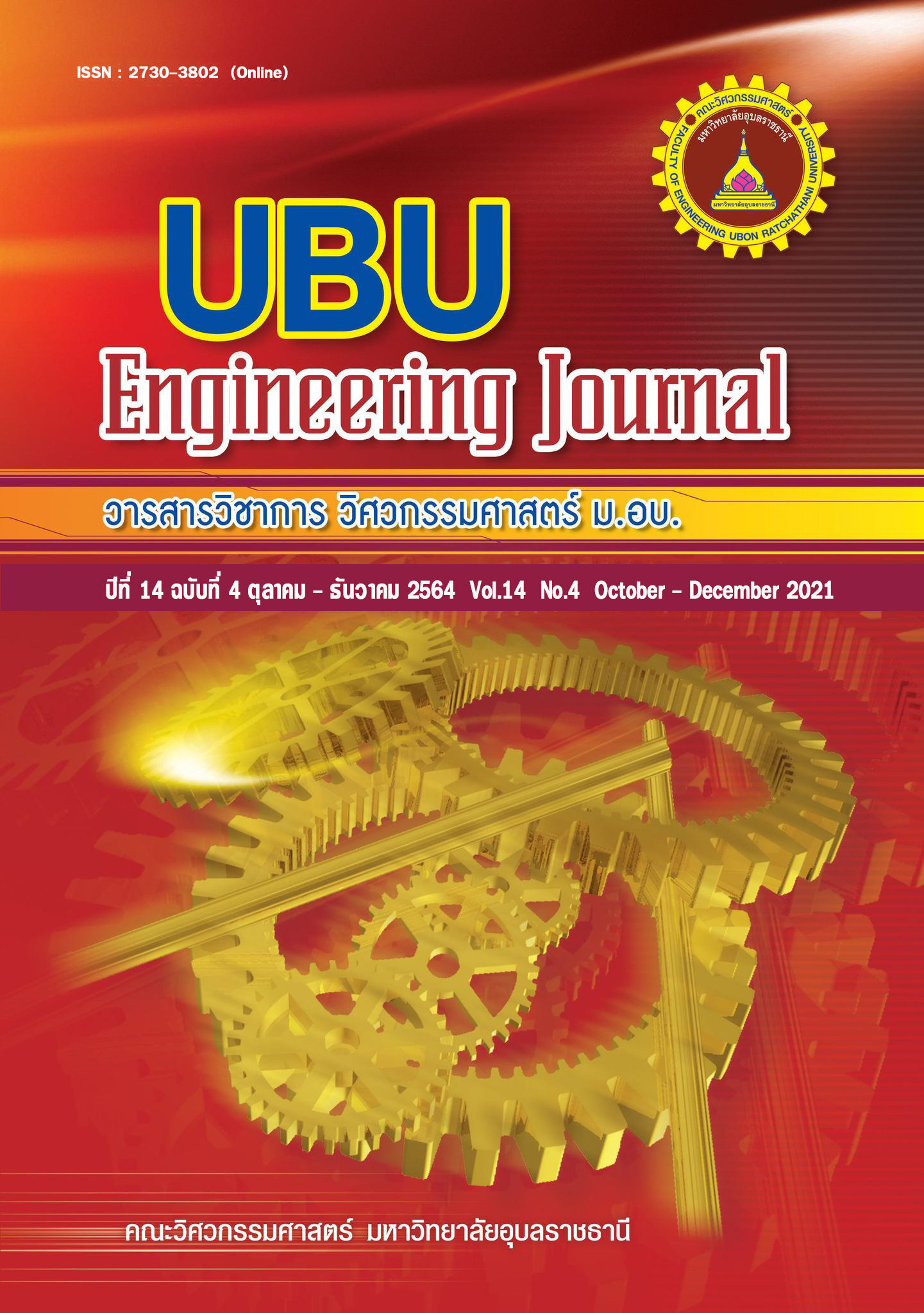Removal of organic matter of treated wastewater effluent from sugar mill factory using UV-H2O2 and UV-persulfate processes for water reuse
Main Article Content
Abstract
Treated effluent from the sugar mill factory has high organic matter, causing color, taste odor, and microbial regrowth. These properties make the water objectional for water reuse. This research investigated the removal of organic matter of treated effluent from of a sugar mill factory using two advanced oxidation processes (AOPs) including Ultraviolet (UV)-H2O2 (UV-H2O2) and UV-persulfate (UV-PS). The effect of oxidants concentration (H2O2 or PS) at the ratio of dissolved organic carbon (DOC) concentrations to H2O2 or PS 1:1, 1:3, and 1:5 to DOC and UV absorbance at 254 nm (UV254) removal, and biodegradability (biodegradable dissolved organic carbon (BDOC)/DOC) was studied. The result showed that an increase in the concentration of H2O2 or PS enhanced the efficiency of DOC and UV254 removals. At the ratio of DOC:H2O2 or DOC:PS 1:5, UV-H2O2 and UV-PS provided the highest organic removal efficiencies by 58% and 62% of UV254 removal, respectively, and 13% and 16% of DOC removal, respectively. UV-H2O2 and UV-PS processes at DOC:H2O2 or DOC:PS 1:1 resulted in the highest BDOC/DOC of 0.48 and 0.60, respectively (increased from 0.29). The increased BDOC/DOC value of water after UV-H2O2 or UV-PS processes indicated the need for biological treatment after AOPs to remove organic matter.
Article Details
References
[2] วนิดา ชูอักษร. เทคโนโลยีการกำจัดสีในน้ำเสียอุตสาหกรรม. Burapha Sci J. 2012;17(1):181–91.
[3] Umar M, Roddick F, Fan L. Impact of coagulation as a pre-treatment for UVC/H2O2-biological activated carbon treatment of a municipal wastewater reverse osmosis concentrate. Water Res. 2016;88:12–9.
[4] Wang JL, Xu LJ. Advanced Oxidation Processes for Wastewater Treatment : Formation of Hydroxyl Radical and Application Advanced Oxidation Processes for Wastewater Treatment : Formation of Hydroxyl Radical. Crit Rev Environ Sci Technol. 2012;42(3):251–325.
[5] นพคุณ เพ็ชรมาก. การกำจัดสีและสารอินทรีย์ในน้ำทิ้งที่ผ่านการบำบัดแล้วจากโรงงานน้ำตาล โดยวิธีการโคแอกกูเลชันร่วมกับ VUV/UV+H2O2 [วิทยานิพนธ์ปริญญาวิศวกรรมศาสตรมหาบัณฑิต]. มหาวิทยาลัยขอนแก่น; 2560.
[6] Umar M, Roddick F, Fan L. Comparison of coagulation efficiency of aluminium and ferric-based coagulants as pre-treatment for UVC/H2O2 treatment of wastewater RO concentrate. Chem Eng J. 2016;284:841–9.
[7] Ahn Y, Lee D, Kwon M, Choi I, Nam S, Kang J. Characteristics and fate of natural organic matter during UV oxidation processes. Chemosphere. 2017;184:960–8.
[8] Puspita P, Roddick FA, Porter NA. Decolourisation of secondary effluent by UV-mediated processes. Chem Eng J. 2011;171(2):464–73.
[9] Rehman F, Sayed M, Khan JA, Shah NS, Khan HM, Dionysiou DD. Oxidative removal of brilliant green by UV/S2O82-, UV/HSO5- and UV/H2O2 processes in aqueous media: A comparative study. J Hazard Mater. 2018;357:506–14.
[10] Zhang Y, Xiao Y, Zhong Y, Lim TT. Comparison of amoxicillin photodegradation in the UV/H2O2 and UV/persulfate systems: Reaction kinetics, degradation pathways, and antibacterial activity. Chem Eng J. 2019;372:420–8.
[11] Miklos DB, Wang W, Linden KG, Drewes JE, Hübner U. Comparison of UV-AOPs (UV/H2O2, UV/PDS and UV/Chlorine) for TOrC removal from municipal wastewater effluent and optical surrogate model evaluation. Chem Eng J. 2019;362:537–47.
[12] Tchobanoglous G, David Stensel H, Tsuchihashi R, Burton F. Wastewater Engineering Treatment and Resource Recovery. 5 th. United State: McGraw-Hill Higher Education; 2013. 207–235 p.
[13] Wacławek S, Lutze H V., Grübel K, Padil VVT, Černík M, Dionysiou DD. Chemistry of persulfates in water and wastewater treatment: A review. Chem Eng J. 2017;330:44–62.
[14] Ike IA, Linden KG, Orbell JD, Duke M. Critical review of the science and sustainability of persulphate advanced oxidation processes. Chem Eng J. 2018;338:651–69.
[15] Gu Y, Chen Y, Sun X, Liu Y. Comparison on mineralization of 2,4,6-tribromophenol by UV-based advanced oxidation processes: UV/Na2S2O8 and UV/H2O2. Res Chem Intermed. 2017;43(5):3095–110.
[16] Khan E, Babcock RW, Suffet IH, Stenstrom MK. Method development for measuring biodegradable organic carbon in reclaimed and treated wastewaters. Water Environ Res. 2006;70(5):1025–32.
[17] Rice E., Baird R, Eaton A., Clesceri L. Standard methods for the examination of water and wastewater. 23rd ed. Standard Methods for the Examination of Water and Wastewater. Washington, D.C: American Public Health Association; 2017.
[18] Babaei AA, Ghanbari F. COD removal from petrochemical wastewater by UV/hydrogen peroxide, UV/persulfate and UV/percarbonate: biodegradability improvement and cost evaluation. J Water Reuse Desalin. 2016;6(4):484–94.
[19] Buchanan W, Roddick F, Porter N, Drikas M. Enhanced biodegradability of UV and VUV pre-treated natural organic matter. Water Sci Technol Water Supply. 2004;4(4):103–11.

